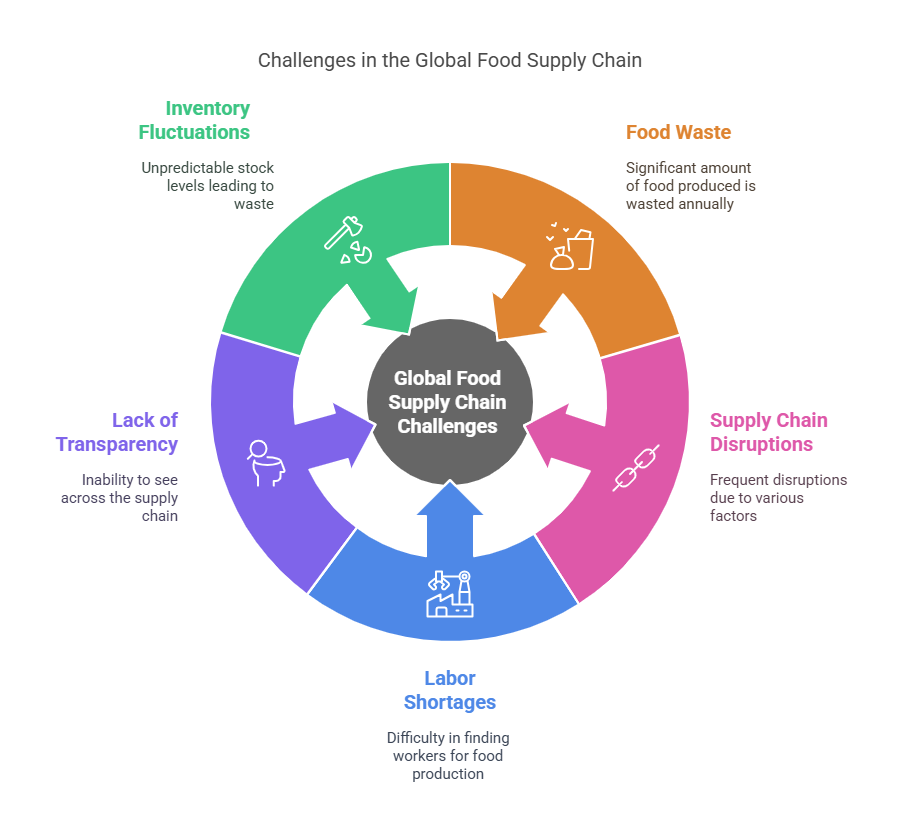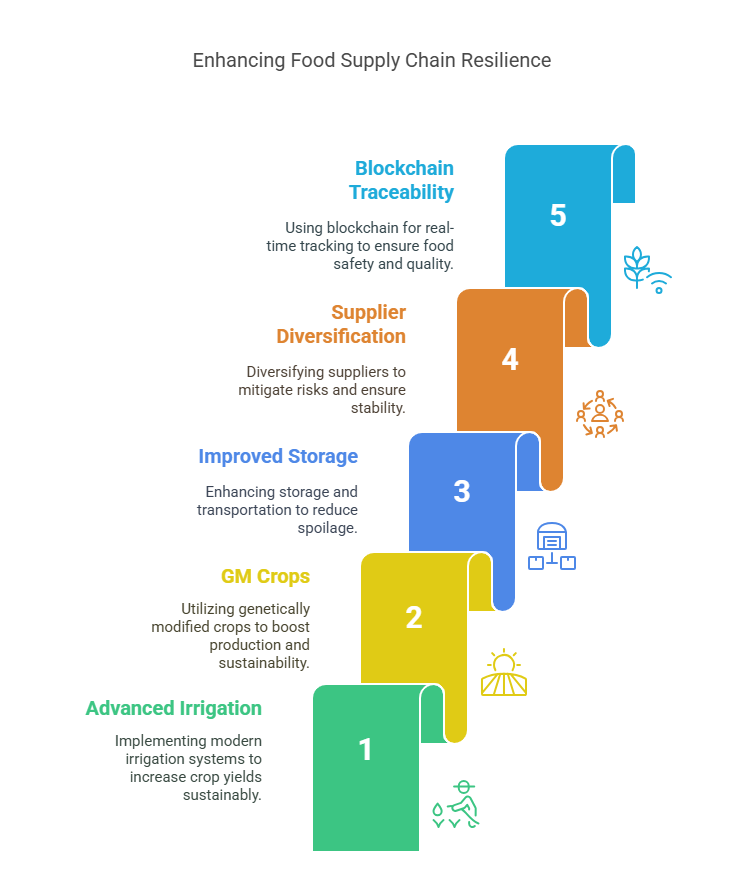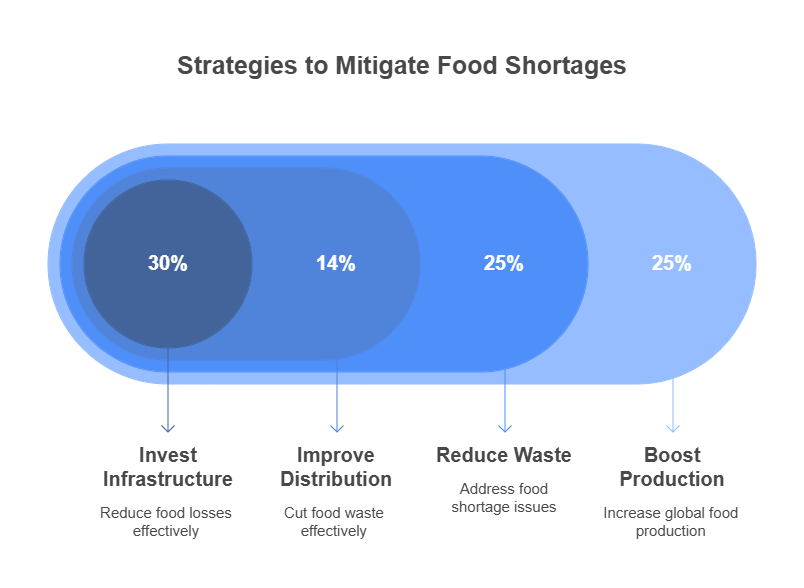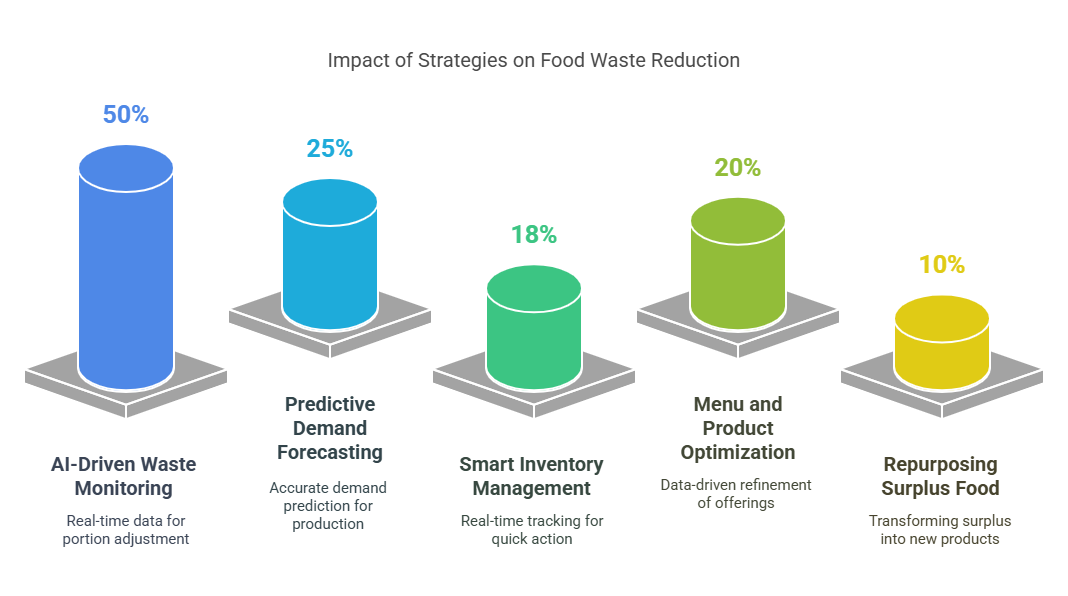You might think that the food supply chain just happens, that food follows a well-laid pattern and makes its way from farms to your table. But we all should know that’s far from the truth. The reality is, the food supply chain is under constant pressure, and it’s anything but smooth sailing. With rising demand, disruptions from all corners, and inefficiencies creeping in at every turn, it can feel like a never-ending struggle. But there’s good news for those of us from the industry here. These problems are not unsolvable. In fact, food manufacturers can take action to overcome them and create a more resilient, sustainable, and profitable food supply network.
Let’s Start By Understanding The Issue
So, there are a lot of moving parts in the food supply chain, right? When everything is running smoothly, we rarely notice it. But when something goes wrong, be it spoilage, shipping delays, or a sudden shortage, it can have a ripple effect. A terrible one at that. But the best part is that these disruptions don’t have to be permanent. Food manufacturers can implement the right strategies to get things back on track and make their supply chains stronger, more efficient, and less wasteful. We are here to explore how to overcome some of the common challenges in the food supply chain and how businesses can implement smarter solutions.
Tips to Overcome Supply Chain Challenges for Food Manufacturers
To understand how to solve the challenges in the food supply chain, it is imperative that we create a clear picture of where and how these challenges arise.
5 Problems Facing the Global Food Supply Chain

1. Food Waste
Did you know that nearly 30% of food produced globally is wasted each year? This is a pressing issue in more ways than one. According to the FAO, about $1 trillion worth of food goes to waste every year. Think of all the resources (water, labor, energy) that go into producing that food, only for it to be thrown away. It’s a huge problem, but we can solve it with the right strategies.
2. Supply Chain Disruptions
Supply chain disruptions seem to be happening more often. Whether it’s a pandemic, climate change, or geopolitical tensions, there’s always something that could throw things off. The Xeneta report shows that over 60% of global businesses have experienced these disruptions in recent years. These disruptions cause delays, shortages, and rising prices, leaving food manufacturers scrambling to adjust.
3. Labor Shortages
The food industry, like many others, is struggling with labor shortages. According to the U.S. Department of Agriculture, it’s becoming harder to find workers, especially for seasonal and low-skilled jobs. With fewer people available to handle production and distribution, everything slows down, leading to higher costs and longer wait times.
4. Lack of Transparency
Here’s a big issue: if you don’t have visibility across your supply chain, how can you identify potential problems? According to Gartner, 43% of supply chain managers say the lack of transparency is a major barrier to improving performance. Without full visibility, it’s impossible to ensure food safety and quality, and react quickly if something goes wrong.
5. Inventory & Demand Fluctuations
One day you have too much stock, and the next day, you’re dealing with stockouts. This unpredictability causes waste and lost sales. According to the Food Institute, 65% of food manufacturers are struggling with managing inventory because of fluctuating demand. It’s a balancing act—too much inventory leads to waste, too little leads to missed opportunities.
What Strategies Can Be Used to Increase, Sustain, and Protect the Food Supply?
To overcome these challenges, food manufacturers need to rely on smarter technology, better practices, and stronger systems. Here’s how we can start:

1. Advanced Irrigation and Mechanization
With modern irrigation systems like drip irrigation and mechanized farming techniques, crop yields can increase without putting extra strain on resources. The World Resources Institute reports that precision farming can boost crop yields by 20%. This helps ensure that food production can meet the rising demand with less environmental impact.
2. Genetically Modified (GM) and High-Yield Crops
GM crops, such as drought-resistant varieties, are an important tool for increasing food production and making it more sustainable. FAO suggests that GM crops could increase food production by up to 50%, especially in areas facing constant environmental challenges. These crops make it possible to grow more food on less land.
3. Improved Storage and Transportation
Refrigerated warehouses, improved logistics, and better transportation systems help reduce spoilage and extend shelf life. The Institute of Food Technologists found that improved cold storage can reduce spoilage by up to 30%. That means more food gets to consumers in good condition and less is wasted.
4. Supplier Diversification
Having multiple suppliers reduces risk. If one supplier experiences a problem, the others can step in. Diversifying suppliers helps food manufacturers stay resilient in the face of unexpected disruptions. The Gartner report shows that businesses with diversified suppliers experience fewer disruptions, which makes their supply chains more stable.
5. Blockchain and Traceability
Blockchain technology allows for real-time tracking of food from farm to table. This makes the entire supply chain more transparent, ensuring food safety and quality. According to Harvard Business Review, blockchain can reduce food waste by improving traceability, which makes it easier to respond quickly to recalls and other issues.
What Is the Best Way to Solve Food Shortage?
Food shortages are complex, but by taking a multi-faceted approach, we can mitigate their effects and ensure food security. Here are some of the most effective strategies:

1. Boost Production with Technology
Adopting advanced technologies like high-yield seeds, precision agriculture, and climate-resilient farming can significantly increase food production.
- Benefit: These techniques help farmers produce more food on the same amount of land, using fewer resources.
- Example: Drought-resistant crops or genetically modified (GM) crops that withstand pests and diseases lead to more consistent food supplies.
- Impact: According to the OECD, these methods can increase global food production by up to 25%.
2. Improve Distribution Systems
Better storage, transport, and logistics can ensure that food reaches underserved areas before it spoils.
- Benefit: Efficient distribution networks prevent food from being wasted in transit, ensuring that products reach consumers in optimal condition.
- Example: Investing in refrigerated transport can reduce spoilage, particularly for perishable goods like dairy, meat, and fresh produce.
- Impact: The FAO estimates that improving distribution systems could cut food waste by 14%, helping food get where it’s needed.
3. Strengthen Local and Regional Food Systems
Developing local food networks helps reduce dependence on long-distance supply chains that are vulnerable to disruptions.
- Benefit: Sourcing food from local farms reduces transport time and spoilage, while supporting local economies.
- Example: Community-supported agriculture (CSA) programs can connect local farms directly to consumers, reducing food shortages in specific areas.
- Impact: Strengthening local food systems can improve food availability by reducing reliance on external suppliers, especially in times of crisis.
4. Invest in Food Security Infrastructure
Building infrastructure such as better storage facilities, better refrigeration, and more efficient transportation networks can help alleviate food shortages.
- Benefit: Reduces waste and improves the shelf life of food, ensuring that more food reaches its destination safely.
- Example: Building more cold storage facilities in developing regions can help preserve perishable food longer, reducing loss during transportation.
- Impact: According to Food and Agriculture Organization, investing in food storage can help improve food security by reducing losses of up to 30%.
5. Improve Global Trade Policies
Reforming trade policies to facilitate food distribution and remove barriers between countries can help mitigate food shortages in regions with high demand.
- Benefit: Countries with surplus food can send it to areas experiencing shortages, improving overall food access.
- Example: Removing tariffs and restrictions on food imports can ensure that countries facing food shortages have a consistent supply from international sources.
- Impact: A World Bank report found that more open trade policies can help reduce food scarcity by improving the efficiency of global food distribution.
6. Enhance Waste Reduction Strategies
In addition to boosting production, we need to reduce the food waste that contributes to food shortages.
- Benefit: Repurposing waste, redistributing surplus, and optimizing inventory management can redirect food that would otherwise be discarded.
- Example: Redirecting surplus food to charities, secondary markets, or for repurposing into value-added products can help ensure more food reaches those in need.
- Impact: Implementing waste reduction strategies globally could help address 25% of food shortage issues by reducing unnecessary waste.
How Can We Reduce Food Waste in the Supply Chain?
Food waste is a pressing issue, and addressing it can lead to major savings for businesses, as well as a more sustainable future. Here’s a breakdown of effective strategies to reduce food waste:

1. AI-Driven Waste Monitoring
AI-powered tools like Winnow can track food waste in real-time, offering insights on the types of food being discarded and why.
- Benefit: Real-time data helps restaurants, warehouses, and manufacturers adjust portions, purchasing, and production schedules to reduce waste.
- Example: In commercial kitchens, AI can analyze what’s being thrown away at every meal prep stage, adjusting inventory levels and portion sizes accordingly.
- Impact: According to Business Insider, businesses that use AI-powered tools can cut food waste by up to 50%, dramatically improving profit margins.
2. Predictive Demand Forecasting
AI algorithms analyze historical sales, consumer behavior, weather patterns, and more to predict demand.
- Benefit: This ensures that the correct amount of food is produced, reducing overproduction and waste.
- Example: If a supplier knows exactly how much product will be needed next week, they won’t overproduce items that may end up going unused and spoiling.
- Impact: By forecasting demand with precision, companies can reduce waste by up to 25%, leading to more efficient food production.
3. Smart Inventory Management
Automated inventory management systems track stock in real-time, notifying you when items are close to expiration or approaching surplus levels.
- Benefit: This allows for quick action to redistribute or reprocess food before it spoils.
- Example: Perishable goods like fresh produce can be flagged for immediate sale or donation to food banks once they approach their sell-by dates.
- Impact: According to Tastewise, this type of system can reduce waste by up to 18%, ensuring that surplus food gets to people who need it instead of going to landfills.
4. Menu and Product Optimization
Using data insights to refine product offerings and menus can drastically cut waste.
- Benefit: By identifying which items are unpopular or underperforming, businesses can stop making products that contribute to waste.
- Example: If a restaurant notices that a certain dish always results in leftovers, they can either modify the portion sizes or discontinue the dish altogether.
- Impact: This data-driven approach can cut food waste by as much as 20%, improving overall sustainability.
5. Repurposing Surplus Food
Rather than letting surplus food go to waste, businesses can repurpose it into new products or donate it.
- Benefit: Surplus can be used in cooking, transformed into by-products, or sent to charities.
- Example: Day-old bread can be turned into croutons or breadcrumbs, and surplus fruits and vegetables can be juiced, canned, or turned into sauces.
- Impact: Repurposing helps cut food waste by at least 10% while contributing positively to local communities and reducing the environmental impact.
The Role of AI Agents, Custom Software, and Integration Services
AI plays a significant role in transforming the food supply chain, but it’s not the only tool. Custom software solutions, like food supply management platforms, also play an essential role. Here’s how:
- Enhancing Forecasting: AI can predict demand, optimize production, and prevent overstock or stockouts, ensuring food is available when needed.
- Automating Operations: From sorting to quality control, AI-powered robots streamline processes, improve efficiency, and maintain hygiene.
- Improving Visibility: Real-time tracking and analytics give businesses full transparency, ensuring food safety and compliance throughout the supply chain.
- Reducing Waste: AI-driven tools like Winnow help pinpoint waste patterns, offering actionable insights that reduce waste and improve sustainability.
Custom software for managing the food supply chain integrates data from various sources, making it easier to track inventory, monitor demand, and ensure everything is running smoothly. Third-party AI integration services, like those offered by Enacton, can easily connect these technologies to your existing systems, bringing automation, real-time insights, and data-driven decision-making to every part of your supply chain.
We Can Conclude This By Saying That
The food supply chain faces its fair share of challenges, but none that can’t be overcome with the right approach. By embracing smarter technologies like AI and custom software, food manufacturers can improve efficiency, reduce waste, and create more resilient networks. The future of the food industry is about embracing these tools, being adaptable, and staying ahead of potential disruptions.
To learn more about how AI integration and custom software solutions can improve your food supply chain, explore our Restaurant Management Software and Foodtech Software Development.
